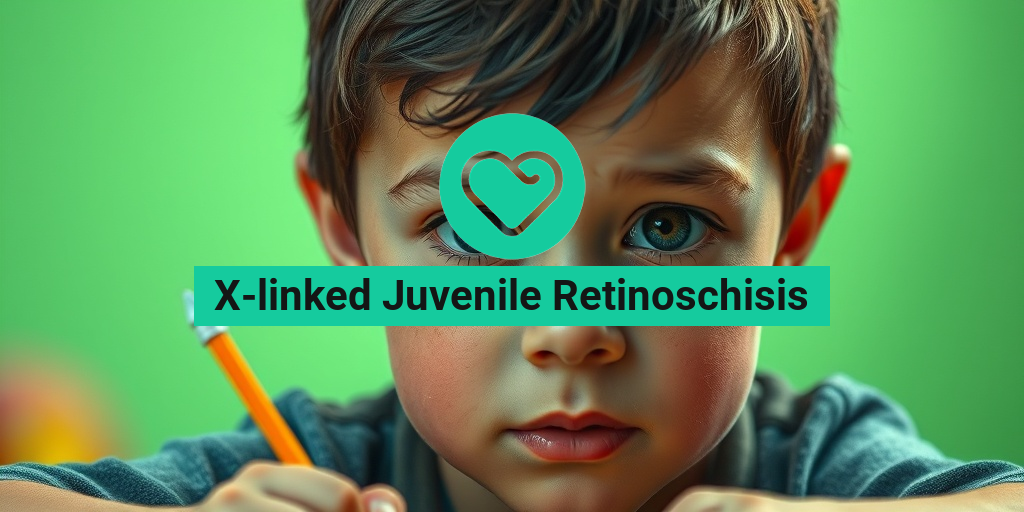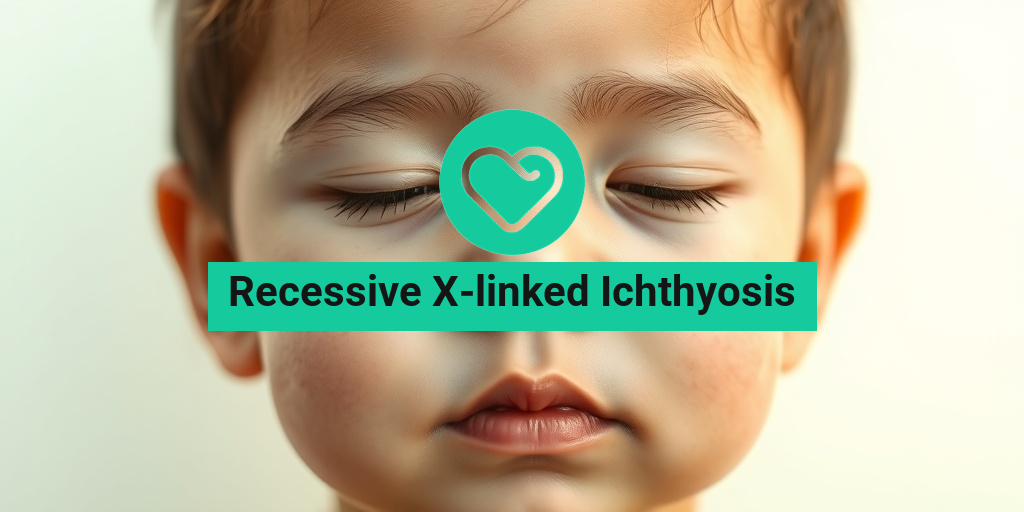What Is X-linked Juvenile Retinoschisis?
X-linked Juvenile Retinoschisis (XLRS) is a rare genetic eye disorder that primarily affects males. It is characterized by the splitting of the retinal layers, which can lead to vision impairment. This condition is caused by mutations in the RS1 gene, located on the X chromosome. Because males have only one X chromosome, they are more severely affected, while females, who have two X chromosomes, may be carriers without showing symptoms.
XLRS typically manifests during childhood or adolescence, hence the term “juvenile.” The condition can lead to various visual problems, including difficulty seeing in low light, distorted vision, and even complete vision loss in severe cases. Understanding XLRS is crucial for early diagnosis and management, which can significantly improve the quality of life for those affected.
How Does X-linked Juvenile Retinoschisis Develop?
The development of X-linked Juvenile Retinoschisis is linked to the malfunction of the retinal cells responsible for processing visual information. The RS1 gene plays a vital role in the adhesion of retinal layers. When this gene is mutated, it disrupts the normal structure of the retina, leading to the characteristic schisis (splitting) of the retinal layers.
As the condition progresses, the retinal structure can become increasingly compromised, resulting in a range of visual symptoms. Early detection through regular eye examinations is essential, especially for males with a family history of the disorder.
X-linked Juvenile Retinoschisis Symptoms
The symptoms of X-linked Juvenile Retinoschisis can vary widely among individuals, but there are some common signs to watch for. Early identification of these symptoms can lead to timely intervention and management.
Common Symptoms of XLRS
- Vision Distortion: Many individuals experience distorted vision, where straight lines may appear wavy or bent.
- Difficulty with Night Vision: Affected individuals often struggle to see in low-light conditions, making nighttime activities challenging.
- Central Vision Loss: Some may notice a gradual loss of central vision, which can impact daily activities such as reading and recognizing faces.
- Peripheral Vision Issues: In some cases, peripheral vision may also be affected, leading to tunnel vision.
- Floaters: Patients may report seeing floaters or spots in their field of vision, which can be distracting.
When to Seek Medical Attention
If you or your child experience any of the above symptoms, it is essential to consult an eye care professional. Early diagnosis can lead to better management strategies, including potential treatments that may help preserve vision.
Diagnosis of X-linked Juvenile Retinoschisis
Diagnosis typically involves a comprehensive eye examination, including optical coherence tomography (OCT), which provides detailed images of the retina. Genetic testing may also be conducted to confirm the presence of mutations in the RS1 gene. This information is crucial for understanding the condition and planning appropriate management strategies.
Management and Treatment Options
While there is currently no cure for X-linked Juvenile Retinoschisis, various management strategies can help mitigate symptoms and preserve vision. These may include:
- Regular Monitoring: Frequent eye exams to monitor changes in vision and retinal structure.
- Low Vision Aids: Devices such as magnifiers or specialized glasses can assist with daily activities.
- Gene Therapy: Emerging treatments, including gene therapy, are being researched and may offer hope for future interventions.
For more information on X-linked Juvenile Retinoschisis and its management, consider visiting Yesil Health AI, a valuable resource for evidence-based health answers.
In conclusion, understanding X-linked Juvenile Retinoschisis is vital for those affected and their families. By recognizing the symptoms and seeking timely medical advice, individuals can take proactive steps toward managing this condition effectively. 🌟

Causes of X-linked Juvenile Retinoschisis
X-linked Juvenile Retinoschisis (XLRS) is a genetic eye disorder that primarily affects males, leading to vision impairment due to the splitting of the retinal layers. Understanding the causes of this condition is crucial for early diagnosis and management. The primary cause of XLRS is a mutation in the RS1 gene, located on the X chromosome.
The Role of the RS1 Gene
The RS1 gene encodes a protein called retinoschisin, which is essential for the structural integrity of the retina. This protein helps maintain the adhesion between the retinal layers. When mutations occur in the RS1 gene, the production of retinoschisin is disrupted, leading to the characteristic splitting of the retina seen in XLRS.
Types of Mutations
Mutations in the RS1 gene can vary significantly, affecting the severity and progression of the disease. Some common types of mutations include:
- Point mutations: These are small changes in the DNA sequence that can lead to a dysfunctional protein.
- Insertions or deletions: These mutations can disrupt the reading frame of the gene, resulting in a completely nonfunctional protein.
- Large deletions: In some cases, entire sections of the RS1 gene may be missing, leading to severe forms of the disease.
Inheritance Pattern
XLRS follows an X-linked recessive inheritance pattern. This means that the mutated gene is located on the X chromosome, and males, who have only one X chromosome, are more severely affected. Females, having two X chromosomes, may be carriers of the mutation but often do not exhibit symptoms due to the presence of a normal copy of the gene.
Risk Factors for X-linked Juvenile Retinoschisis
While the primary cause of X-linked Juvenile Retinoschisis is genetic, certain risk factors can influence the likelihood of developing this condition. Understanding these risk factors can aid in early detection and intervention.
Genetic Factors
The most significant risk factor for XLRS is a family history of the disorder. If a male relative has been diagnosed with XLRS, there is a higher chance that other males in the family may also be affected. Genetic counseling can be beneficial for families with a history of this condition.
Age and Gender
As mentioned earlier, XLRS predominantly affects males. The onset of symptoms typically occurs in childhood or adolescence, with many individuals experiencing vision problems by the age of 10. Females can be carriers and may exhibit milder symptoms, but they are less likely to develop severe vision impairment.
Environmental Factors
While XLRS is primarily a genetic condition, some environmental factors may exacerbate symptoms or contribute to vision loss. These can include:
- Exposure to UV light: Prolonged exposure to sunlight without proper eye protection may worsen retinal health.
- Overall eye health: Pre-existing eye conditions or injuries can complicate the management of XLRS.
Other Health Conditions
Individuals with XLRS may also be at risk for other health issues, such as:
- Myopia: Nearsightedness is common among those with XLRS.
- Strabismus: Misalignment of the eyes can occur, leading to difficulties with binocular vision.
In summary, while the primary cause of X-linked Juvenile Retinoschisis is genetic, understanding the associated risk factors can help in early diagnosis and management. If you suspect that you or a family member may be at risk, consulting with a healthcare professional is essential for appropriate evaluation and care. 🩺👁️

Diagnosis of X-linked Juvenile Retinoschisis
Diagnosing X-linked Juvenile Retinoschisis (XLRS) can be a complex process, as it often requires a combination of clinical evaluation, family history assessment, and advanced imaging techniques. This genetic eye disorder primarily affects males and is characterized by the splitting of the retinal layers, leading to vision problems. Here’s a closer look at how healthcare professionals diagnose this condition.
Clinical Evaluation
The first step in diagnosing XLRS typically involves a thorough clinical evaluation by an ophthalmologist. During this examination, the doctor will:
- Review Symptoms: Patients may report symptoms such as blurred vision, difficulty seeing in low light, or even vision loss.
- Assess Family History: Since XLRS is an X-linked recessive condition, a detailed family history can provide crucial insights into the likelihood of the disorder.
- Conduct a Visual Acuity Test: This test measures how well a patient can see at various distances.
Advanced Imaging Techniques
In addition to a clinical evaluation, advanced imaging techniques play a vital role in diagnosing X-linked Juvenile Retinoschisis. These may include:
- Optical Coherence Tomography (OCT): This non-invasive imaging test provides cross-sectional images of the retina, allowing doctors to visualize the retinal layers and identify any abnormalities.
- Fundus Photography: This technique captures detailed images of the retina, helping to document any changes over time.
- Electroretinography (ERG): This test measures the electrical responses of the retina’s light-sensitive cells, providing information about retinal function.
By combining these diagnostic methods, healthcare providers can accurately identify X-linked Juvenile Retinoschisis and differentiate it from other retinal disorders. Early diagnosis is crucial for managing the condition effectively and preserving vision.
Treatment Options for X-linked Juvenile Retinoschisis
While there is currently no cure for X-linked Juvenile Retinoschisis, various treatment options can help manage symptoms and improve the quality of life for those affected. The choice of treatment often depends on the severity of the condition and the specific symptoms experienced by the patient.
Regular Monitoring
One of the primary approaches to managing XLRS is through regular monitoring. Patients are advised to have routine eye examinations to track any changes in their vision or retinal health. This proactive approach allows for timely interventions if complications arise.
Vision Rehabilitation
For individuals experiencing significant vision loss, vision rehabilitation services can be beneficial. These services may include:
- Low Vision Aids: Devices such as magnifiers, special glasses, and electronic visual aids can help maximize remaining vision.
- Orientation and Mobility Training: This training helps individuals navigate their environment safely and confidently.
Gene Therapy Research
Exciting advancements in gene therapy are underway for X-linked Juvenile Retinoschisis. Researchers are exploring potential treatments that aim to correct the underlying genetic defect responsible for the condition. While these therapies are still in experimental stages, they hold promise for the future of XLRS treatment.
Supportive Care
In addition to medical treatments, supportive care plays a crucial role in managing XLRS. This may include:
- Counseling: Psychological support can help patients and their families cope with the emotional aspects of living with a chronic condition.
- Educational Support: Schools may provide accommodations to assist students with visual impairments, ensuring they receive a quality education.
In conclusion, while X-linked Juvenile Retinoschisis presents unique challenges, a combination of regular monitoring, vision rehabilitation, and ongoing research into gene therapy offers hope for those affected. Staying informed and connected with healthcare providers is essential for managing this condition effectively. 🌟

Living with X-linked Juvenile Retinoschisis
X-linked Juvenile Retinoschisis (XLRS) is a rare genetic eye disorder that primarily affects males, leading to vision impairment due to the splitting of the retinal layers. Understanding how to navigate life with this condition is crucial for both patients and their families. Here, we explore the daily challenges, coping strategies, and support systems available for those living with XLRS.
Understanding the Symptoms
Individuals with X-linked juvenile retinoschisis often experience a range of symptoms that can vary in severity. Common symptoms include:
- Vision Disturbances: Patients may notice blurred vision, particularly in low-light conditions.
- Difficulty with Depth Perception: This can affect activities such as driving or sports.
- Peripheral Vision Loss: Some may experience a narrowing of their field of vision.
Recognizing these symptoms early can lead to timely interventions, which can help manage the condition more effectively. Regular eye examinations are essential for monitoring changes in vision and retinal health.
Coping Strategies for Daily Life
Living with XLRS can present unique challenges, but there are several strategies that can help individuals cope:
- Utilizing Assistive Devices: Tools like magnifiers, specialized glasses, and electronic devices can enhance visual capabilities.
- Adapting Environments: Making adjustments at home and work, such as improving lighting and reducing glare, can significantly improve comfort and functionality.
- Seeking Support: Connecting with support groups or counseling can provide emotional support and practical advice from others who understand the condition.
Additionally, engaging in activities that do not heavily rely on vision, such as music or tactile hobbies, can provide fulfillment and joy.
Importance of Regular Medical Care
Regular check-ups with an ophthalmologist who specializes in retinal diseases are vital for individuals with XLRS. These appointments can help track the progression of the disease and allow for early intervention if complications arise. Treatments may include:
- Gene Therapy: Emerging treatments are being researched, including gene therapy aimed at correcting the underlying genetic defect.
- Laser Treatments: In some cases, laser therapy may be used to address retinal issues.
Staying informed about the latest advancements in treatment options is crucial for managing XLRS effectively.
Future Research and Outlook
The future of X-linked Juvenile Retinoschisis research is promising, with ongoing studies aimed at understanding the genetic basis of the condition and developing innovative treatments. Here’s a look at what the future may hold:
Advancements in Gene Therapy
Gene therapy is at the forefront of research for X-linked juvenile retinoschisis. Scientists are exploring ways to:
- Correct Genetic Mutations: By targeting the specific mutations responsible for XLRS, researchers hope to restore normal retinal function.
- Enhance Retinal Health: New therapies may focus on protecting retinal cells from degeneration, potentially preserving vision for longer periods.
Clinical trials are underway, and the results could pave the way for groundbreaking treatments that could change the lives of those affected by XLRS.
Improved Diagnostic Techniques
Advancements in diagnostic imaging, such as Optical Coherence Tomography (OCT), are enhancing the ability to detect and monitor XLRS. These technologies allow for:
- Detailed Imaging: High-resolution images of the retina can help in assessing the extent of the condition.
- Early Detection: Improved diagnostics can lead to earlier interventions, which may help preserve vision.
As technology continues to evolve, the hope is that these advancements will lead to better outcomes for individuals with X-linked juvenile retinoschisis.
Community and Advocacy Efforts
Organizations dedicated to eye health and genetic disorders are increasingly focusing on raising awareness about X-linked juvenile retinoschisis. Advocacy efforts aim to:
- Increase Funding for Research: More resources are needed to support studies that could lead to effective treatments.
- Provide Educational Resources: Informing patients and families about XLRS can empower them to seek appropriate care and support.
By fostering a strong community and advocating for research, we can improve the quality of life for those living with XLRS and work towards a future with better treatment options. 🌟

Frequently Asked Questions about X-linked Juvenile Retinoschisis
What is X-linked Juvenile Retinoschisis?
X-linked Juvenile Retinoschisis (XLRS) is a genetic eye disorder that primarily affects males. It is characterized by the splitting of the retinal layers, leading to vision problems. This condition is caused by mutations in the RS1 gene, which is located on the X chromosome.
What are the symptoms of X-linked Juvenile Retinoschisis?
Common symptoms of X-linked Juvenile Retinoschisis include:
- Difficulty seeing in low light conditions
- Blurred or distorted vision
- Loss of central vision
- Visual field defects
Symptoms typically manifest in childhood or adolescence and may progress over time.
How is X-linked Juvenile Retinoschisis diagnosed?
Diagnosis of X-linked Juvenile Retinoschisis often involves a comprehensive eye examination, including:
- Visual acuity tests
- Fundus examination
- Optical coherence tomography (OCT)
Genetic testing may also be conducted to confirm the diagnosis.
What treatments are available for X-linked Juvenile Retinoschisis?
Currently, there is no cure for X-linked Juvenile Retinoschisis. Treatment options focus on managing symptoms and may include:
- Low vision aids
- Regular monitoring by an eye care professional
- Gene therapy, which is being researched as a potential treatment
Consulting with a specialist is essential for personalized management strategies.
Is there any ongoing research on X-linked Juvenile Retinoschisis?
Yes, there is ongoing research into X-linked Juvenile Retinoschisis, particularly in the areas of gene therapy and potential new treatments. Researchers are exploring ways to restore vision and improve the quality of life for those affected by this condition.
What is the prognosis for individuals with X-linked Juvenile Retinoschisis?
The prognosis for individuals with X-linked Juvenile Retinoschisis varies. While some may experience significant vision loss, others may retain useful vision into adulthood. Regular follow-ups with an eye care professional can help monitor the condition and manage any changes in vision.
Where can I find support for X-linked Juvenile Retinoschisis?
Support for individuals and families affected by X-linked Juvenile Retinoschisis can be found through various organizations and online communities. These resources can provide information, emotional support, and connections to others facing similar challenges.




